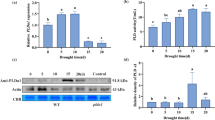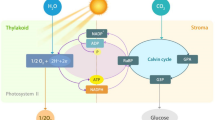Abstract
The activity of ribulose-1,5-bisphosphate carboxylase/oxygenase fromEuglena gracilis decays steadily when exposed to agents that induce oxidative modification of cysteine residues (Cu2+, benzofuroxan, disulfides, arsenite, oxidized ascorbate). Inactivation takes place with a concomitant loss of cysteine sulfhydryl groups and dimerization of large subunits of the enzyme. 40% activity loss induced by the vicinal thiol-reagent arsenite is caused by modification of a few neighbor residues while the almost complete inactivation achieved with disulfides is due to extensive oxidation leading to formation of mixed disulfides with critical cysteines of the protein. In most cases oxidative inactivation is also accompanied by an increased sensitivity to proteolysis by trypsin, chymotrypsin or proteinase K. Both enzymatic activity and resistance to proteolysis can be restored through treatment with several thiols (cysteamine, cysteine, dithiothreitol and, more slowly, reduced glutathione). Redox effectors which are thought to regulate the chloroplast activity (NADPH, ferredoxin and thioredoxin) do not reactivate the oxidized enzyme. When ribulose-1,5-bisphoshate carboxylase/oxygenase is incubated with cystamine/cysteamine mixtures having different disulfide/thiol ratio (r), inactivation takes place around r=1.5 while proteolytic sensitization occurs under more oxidative conditions (r=4). It is suggested that oxidative modification may happen in vivo under exceptional circumstances, such as senescence, bleaching or different kinds of stress, leading to enzyme inactivation and triggering the selective degradation of the carboxylase that has been repeatedly observed during these processes.
Similar content being viewed by others
Abbreviations
- CSH:
-
cysteamine
- CSSC:
-
cystamine
- DTNB:
-
5,5′-dithiobis(2-nitrobenzoic acid)
- DTT:
-
dithiothreitol
- GSH:
-
reduced glutathione
- GSSG:
-
oxidized glutathione
- ribulose-P2 :
-
ribulose-1,5-bisphosphate
- Rubisco:
-
ribulose-1,5-bisphosphate carboxylase/oxygenase
References
Anderson I, Knight S, Schneider G, Lundqvist Y, Lundqvist T, Bränden CI and Lorimer GH (1989) Crystal structure of the active site of ribulose-bisphosphate carboxylase. Nature 337: 229–234
Andrews TJ and Lorimer GH (1987) Rubisco: Structure, mechanism and prospects for improvement. In: Hatch MD and Boardman NK (eds) The Biochemistry of Plants, Vol 10, pp 131–218. Academic Press, San Diego
Arnon DI (1949) Copper enzymes in isolated chloroplasts. Polyphenol oxidase inBeta vulgaris. Plant Physiol 24: 1–15
Camp PJ, Huber SC and Moreland DE (1984) Changes in enzymes of sucrose metabolism and the activation of certain chloroplast enzymes during wheat [Triticum aestivum cultivar Roy] leaf senescence. J Exp Bot 35: 659–668
Coates JB and Davies DD (1983) The molecular basis of the selectivity of protein degradation in stressed senescent barley (Hordeum vulgare cv Proctor) leaves. Planta 158: 550–559
Crafts-Brandner SJ, Salvucci ME and Egli DE (1990) Changes in ribulosebisphorphate carboxylase oxygenase and ribulose 5-phosphate kinase abundances and photosynthetic capacity during leaf senescence. Photosynth Res 23: 223–230
Crawford NA, Droux M, Kosover NS and Buchanan BB (1989) Evidence and function of the ferredoxin/thioredoxin system in the reductive activation of target enzymes of isolated intact chloroplasts. Arch Biochem Biophys 271: 223–239
Ellis RJ (1979) The most abundant protein in the world. Trends Biochem Sci 4: 241–244
Feller U (1986) Proteolytic enzymes in relation to leaf senescence. In: Dalling MJ (ed) Plant Proteolytic Enzymes, Vol II, pp 49–68. CRC Press, Boca Ratón
Ferreira RB and Davies DD (1987) Protein degradation inLemna with particular reference to ribulose bisphosphate carboxylase. Plant Physiol 83: 878–883
Ferreira RB and Davies DD (1989) Conversion of ribulose-1,5-bisphosphate carboxylase to an acidic and catalytically inactive form by extracts of osmotically stressedLemna minor fronds. Planta 179: 448–455
Ferreira RB and Shaw NM (1989) Effect of osmotic stress on protein turnover inLemna minor fronds. Planta 179: 456–465
Freyssinet G, Eichholz RL and Buetow DE (1984) Kinetics of accumulation of ribulose-1,5-bisphosphate carboxylase during greening inEuglena gracilis. Plant Physiol 75: 850–857
Gilbert HF (1982) Biological disufides: The third messenger? J Biol Chem 257: 12086–12091
Gill SC and vonHippel PH (1989) Calculation of protein extinction coefficients from amino acids sequence data/ Anal Biochem 182: 319–326
Gingrich JC and Hallick RB (1985) TheEuglena gracilis chloroplast ribulose-1,5-bisphosphate carboxylase gene. I. Complete DNA sequence and analysis of the nine intervening sequences. J Biol Chem 260: 16162–16168
Goldwaithe J and Bogorad L (1975) Ribulose-1,5-diphosphate carboxylase from leaf. Methods Enzimol 42: 481–487
Hall NP, Keys AJ and Merret MJ (1978) Ribulose-1,5-diphosphate carboxylase protein during flag leaf senescence. J Exp Bot 29: 31–37
Halliwell B and Gutteridge JMC (1989) Free Radicals in Biology and Medicine, 2nd ed, p 287. Clarendon Press, Oxford
Hartman FC, Stringer CD and Lee EH (1984) Complete primary structure of ribulose bisphosphate carboxylase/oxygenase fromRhodospirillum rubrum. Arch Biochem Biophys 232: 280–295
Huffaker RC (1982) Biochemistry and physiology of leaf proteins. In: Boulter D and Parthier B (eds) Nucleic Acids and Proteins in Plants (Encyclopedia of Plant Physiology, New Series) Vol 14A, pp 370–400, Springer Verlag, Berlin
Huffaker RC and Miller BL (1978) Reutilization of ribulose bisphosphate carboxylase. In: Siegelman HW and Hind G (eds) Photosynthetic Carbon Assimilation, pp 139–152. Plenum Press, New York
Huner NPA, Carter JV and Wold F (1982) Effects of reducing agent on the conformation of the isolated subunits of ribulose bisphosphate carboxylase/oxygenase from cold-hardened and unhardened rye. Z Pflanzenphysiol 106: 69–80
Kang SM and Titus JS (1980) Qualitative and quantitative changes in nitrogenous compounds in senescing leaf and bark tissues of the apple. Physiol Plant 50: 285–290
Knaff DB (1989) The regulatory role of thioredoxin in chloroplasts. Trends Biochem Sci 14: 433–434
Knight S, Andersson I and Bränden CI (1990) Crystallographic analysis of ribulose- 1,5-bisphosphate carboxylase from spinach at 2.4 Å resolution-Subunit interactions and active site. J Mol Biol 215: 113–160
Laemmli UK (1970) Cleavage of structural proteins during the assembly of the head of bacteriophage T4. Nature 227: 680–685
Lorimer GH, Badger MR and Andrews TJ (1977) Dribulose-1,5-bisphosphate carboxylase-oxygenase. Improved methods for the activation and assay of catalytic activities. Anal Biochem 78: 66–75
Mehta RA, Fawcett TW, Porath D and Mattoo AK (1992) Oxidative stress causes rapid membrane translocation and in vivo degradation of ribulose-1,5-bisphosphate carboxylase/oxygenase. J Biol Chem 267: 2810–2816
Moreno J and García-Martínez JL (1984) Nitrogen accumulation and mobilization inCitrus leaves throughout the annual cycle. Physiol Plant 61: 429–434
Ortiz W and Wilson CJ (1988) Induced changes in chloroplast protein accumulation during heat bleaching inEuglena gracilis. Plant Physiol 86: 544–561
Peñarrubia L and Moreno J (1987) Spontaneous and shear-induced inactivation of ribulose-1,5-bisphosphate carboxylase/oxygenase in vitro. Biochim Biophys Acta 916: 227–235
Peñarrubia L and Moreno J (1988) Ribulose-1,5-bisphosphate carboxylase/oxygenase fromCitrus leaves. Phytochemistry 27: 1999–2004
Peñarrubia L and Moreno J (1990) Increased susceptibility of ribulose-1,5-bisphosphate carboxylase oxygenase to proteolytic degradation caused by oxidative treatments. Arch Biochem Biophys 281: 319–323
Peterson LW and Huffaker RC (1975) Loss of RDP carboxylase and increase of proteolytic activity in senescence of detached primary barley leaves. Plant Physiol 78: 121–125
Pickersgill RW (1986) An upper limit to the active site concentration of ribulose bisphosphate carboxylase in chloroplasts. Biochem J 236: 311
Price CA and Reardon EN (1982) Isolation of chloroplasts for protein synthesis from spinach andEuglena gracilis by centrifugation in silica sols. In: Edelman M, Hallick RB and Chua N-H (eds) Methods in Chloroplast Molecular Biology, pp 189–209. Elsevier Biomedical Press, Amsterdam
Ranty B, Lorimer G and Gutteridge S (1991) An intradimerick crosslink of large subunits of spinach ribulose-1,5-bisphosphate carboxylase/oxygenase is formed by oxidation of cysteine 247. Eur J Biochem 200: 353–358
Riddles PW, Blakeley RL and Zerner B (1983) Reassessment of Ellman's reagent. Methods Enzymol 91: 49–60
Rintamäki E (1989) Formation of disulphide cross-linked aggregates of large subunit from higher plant ribulose-1,5-bisphosphate carboxylase-oxygenase. J Exp Bot 40: 1305–1313
Sailland A, Amiri I and Freyssinet G (1986) Amino acid sequence of the ribulose-1,5-bisphosphate carboxylase small subunit fromEuglena. Plant Mol Biol 7: 213–218
Scheibe R (1991) Redox-modulation of chloroplast enzymes. Plant Physiol 96: 1–3
Schloss JV, Stringer CD and Hartman FC (1978) Identification of essential lysyl and cysteinyl residues in spinach Rubisco modified by the affinity label N-bromoacetylethanolamine phosphate. J Biol Chem 253: 5707–5711
Seftor RE and Jensen RG (1986) Causes for the disappearance of photosynthetic CO2 fixation with isolated spinach chloroplasts. Plant Physiol 81: 81–85
Shurtz-Swirski R and Gepstein S (1985) Proteolysis of endogenous substrates in senescing oat leaves. Plant Physiol 78: 121–125
Slovacek RE and Vaughn S (1982) Chloroplast sulfhydryl groups and the light activation of fructose-1,6-bisphosphatase. Plant Physiol 70: 978–981
Sugiyama T, Nakayama N, Ogawa M, Akazawa T and Oda T (1968) Structure and function of chloroplast proteins. II. Effect of p-chloromercuribenzoate treatment of the ribulose 1,5-diphosphate carboxylase activity of spinach leaf fraction I protein. Arch Biochem Biophys 125: 98–106
Tenaud M and Jacquot JP (1987) In vitro thiol-dependent redox regulation of purified ribulose-1,5-bisphosphate carboxylase. J Plant Physiol 130: 315–326
Tomimatsu Y (1980) Macromolecular properties and subunit interactions of ribulose-1,5-bisphosphate carboxylase from alfalfa. Biochim Biophys Acta 662: 85–93
Torchinsky YM (1981) Sulfur in Proteins, pp 46–47. Pergamon Press, Oxford
Wittenbach VA (1978) Breakdown of ribulose bisphosphate carboxylase and change in protolytic activity during dark-induced sensescence of wheat seedlings. Plant Physiol 62: 604–608
Author information
Authors and Affiliations
Rights and permissions
About this article
Cite this article
García-Ferris, C., Moreno, J. Redox regulation of enzymatic activity and proteolytic susceptibility of ribulose-1,5-bisphosphate carboxylase/oxygenase fromEuglena gracilis . Photosynth Res 35, 55–66 (1993). https://doi.org/10.1007/BF02185411
Received:
Accepted:
Issue Date:
DOI: https://doi.org/10.1007/BF02185411




